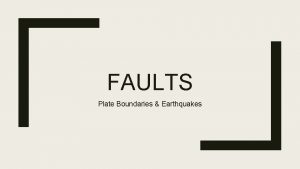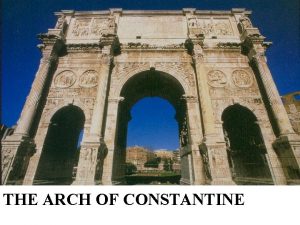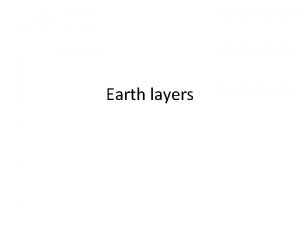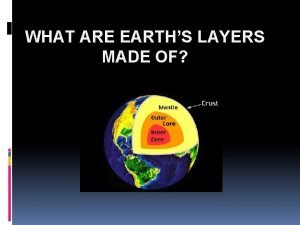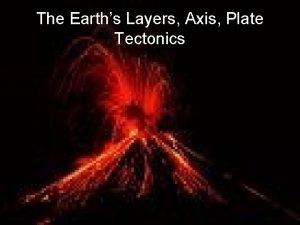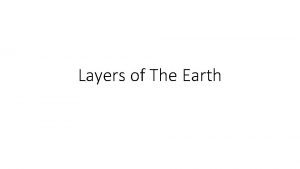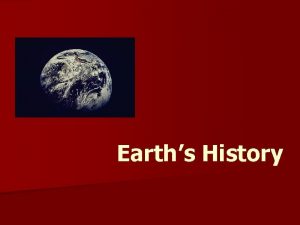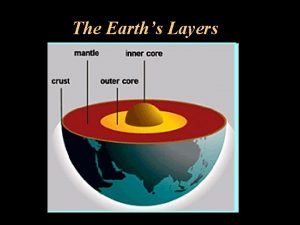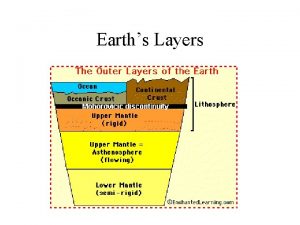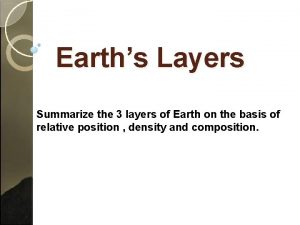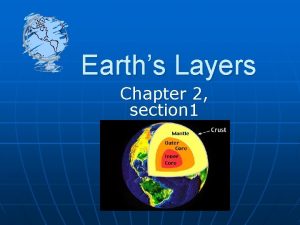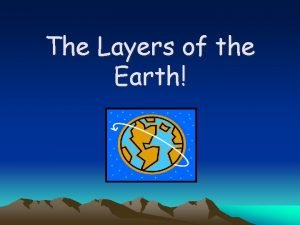Layers of the Earth Earths Layers The earth















- Slides: 15

Layers of the Earth

Earth’s Layers �The earth is divided into four main layers 1. Crust 2. Mantle 3. Outer Core 4. Inner Core

Crust �The Crust is the thinnest layer of the earth It is similar to the skin of an apple �The Crust is open to the atmosphere This makes it cool off and harden The Atmosphere

Crust �The Crust is where we live It exists under the oceans as well


Crust FUN FACT! The world’s crust is broken up into many pieces These pieces are called Tectonic Plates (like a puzzle)

Tectonic Plates are always moving! Caused by the pressure that builds up within the layers due to heat The Heat must be released!

Tectonic Plates Where different plates meet is called the plate boundary The Heat and Pressure are “released” at plate boundaries �There are three types of plate boundaries: 1. Divergent 2. Convergent 3. Transform

Tectonic Plates WHY CARE? ? ?

Tectonic Plates 1. Divergent Boundary Tectonic plates separate from one another (they move away) They are pulled apart from magma underneath Once they pull apart, magma rises and cools

Tectonic Plates 2. Convergent boundary Plates are crashing toward ones another This occurs due to pressure from underneath Ex: Earthquakes and volcanoes

Tectonic Plates 3. Transform boundary Plates slide against one another Movement is not smooth Plates can lock together and get stuck Ex. Earthquakes

Mantle �Layer under the crust �This is the largest layer �Made of solid rock that flows very slowly �Magma flows underneath the crust and rises to the surface through cracks between the plates �This layer helps create pressure against the tectonic plates


Core �Outer core: superheated liquid molten lava �Inner core: so hot that it is solid Temperatures are so high that metals are squeezed together
 Layers of the atmosphere
Layers of the atmosphere Earth layers foldable
Earth layers foldable Dinah.com earth's layers foldable
Dinah.com earth's layers foldable Earths orbit seasons
Earths orbit seasons Home sweet biome crossword
Home sweet biome crossword Earths boundaries
Earths boundaries Pangea explanation
Pangea explanation Which layer of the earth slowly moves like putty
Which layer of the earth slowly moves like putty Describe the true shape of earth's orbit
Describe the true shape of earth's orbit Brown earth soil ireland
Brown earth soil ireland Chalogen elements
Chalogen elements Earths 4 spheres
Earths 4 spheres Earths crust
Earths crust Earths early atmosphere contained
Earths early atmosphere contained Arch of constantine frieze
Arch of constantine frieze Earths roation
Earths roation





